Series Foreword
Preface
Symbols and Notation
Introduction
A Pictorial Introduction to Bayesian Modelling
Roadmap
Regression
Weight-space View
The Standard Linear Model
Projections of Inputs into Feature Space
Function-space View
Varying the Hyperparameters
Decision Theory for Regression
An Example Application
Smoothing, Weight Functions and Equivalent Kernels
* Incorporating Explicit Basis Functions
Marginal Likelihood
History and Related Work
Exercises
Classification
Classification Problems
Decision Theory for Classification
Linear Models for Classification
Gaussian Process Classification
The Laplace Approximation for the Binary GP Classifier
Posterior
Predictions
Implementation
Marginal Likelihood
* Multi-class Laplace Approximation
Implementation
Expectation Propagation
Predictions
Marginal Likelihood
Implementation
Experiments
A Toy Problem
One-dimensional Example
Binary Handwritten Digit Classification Example
10-class Handwritten Digit Classification Example
Discussion
* Appendix: Moment Derivations
Exercises
Covariance Functions
Preliminaries
* Mean Square Continuity and Differentiability
Examples of Covariance Functions
Stationary Covariance Functions
Dot Product Covariance Functions
Other Non-stationary Covariance Functions
Making New Kernels from Old
Eigenfunction Analysis of Kernels
* An Analytic Example
Numerical Approximation of Eigenfunctions
Kernels for Non-vectorial Inputs
String Kernels
Fisher Kernels
Exercises
Model Selection and Adaptation of Hyperparameters
The Model Selection Problem
Bayesian Model Selection
Cross-validation
Model Selection for GP Regression
Marginal Likelihood
Cross-validation
Examples and Discussion
Model Selection for GP Classification
* Derivatives of the Marginal Likelihood for Laplace's Approximation
* Derivatives of the Marginal Likelihood for EP
Cross-validation
Example
Exercises
Relationships between GPs and Other Models
Reproducing Kernel Hilbert Spaces
Regularization
* Regularization Defined by Differential Operators
Obtaining the Regularized Solution
The Relationship of the Regularization View to Gaussian Process Prediction
Spline Models
* A 1-d Gaussian Process Spline Construction
* Support Vector Machines
Support Vector Classification
Support Vector Regression
* Least-squares Classification
Probabilistic Least-squares Classification
* Relevance Vector Machines
Exercises
Theoretical Perspectives
The Equivalent Kernel
Some Specific Examples of Equivalent Kernels
* Asymptotic Analysis
Consistency
Equivalence and Orthogonality
* Average-case Learning Curves
* PAC-Bayesian Analysis
The PAC Framework
PAC-Bayesian Analysis
PAC-Bayesian Analysis of GP Classification
Comparison with Other Supervised Learning Methods
* Appendix: Learning Curve for the Ornstein-Uhlenbeck Process
Exercises
Approximation Methods for Large Datasets
Reduced-rank Approximations of the Gram Matrix
Greedy Approximation
Approximations for GPR with Fixed Hyperparameters
Subset of Regressors
The Nyström Method
Subset of Datapoints
Projected Process Approximation
Bayesian Committee Machine
Iterative Solution of Linear Systems
Comparison of Approximate GPR Methods
Approximations for GPC with Fixed Hyperparameters
* Approximating the Marginal Likelihood and its Derivatives
* Appendix: Equivalence of SR and GPR Using the Nyström Approximate Kernel
Exercises
Further Issues and Conclusions
Multiple Outputs
Noise Models with Dependencies
Non-Gaussian Likelihoods
Derivative Observations
Prediction with Uncertain Inputs
Mixtures of Gaussian Processes
Global Optimization
Evaluation of Integrals
Student's t Process
Invariances
Latent Variable Models
Conclusions and Future Directions
Appendix Mathematical Background
Joint, Marginal and Conditional Probability
Gaussian Identities
Matrix Identities
Matrix Derivatives
Matrix Norms
Cholesky Decomposition
Entropy and Kullback-Leibler Divergence
Limits
Measure and Integration
Lp Spaces
Fourier Transforms
Convexity
Appendix Gaussian Markov Processes
Fourier Analysis
Sampling and Periodization
Continuous-time Gaussian Markov Processes
Continuous-time GMPs on R
The Solution of the Corresponding SDE on the Circle
Discrete-time Gaussian Markov Processes
Discrete-time GMPs on Z
The Solution of the Corresponding Difference Equation on PN
The Relationship Between Discrete-time and Sampled Continuous-time GMPs
Markov Processes in Higher Dimensions
Appendix Datasets and Code
Bibliography
Author Index
Subject Index
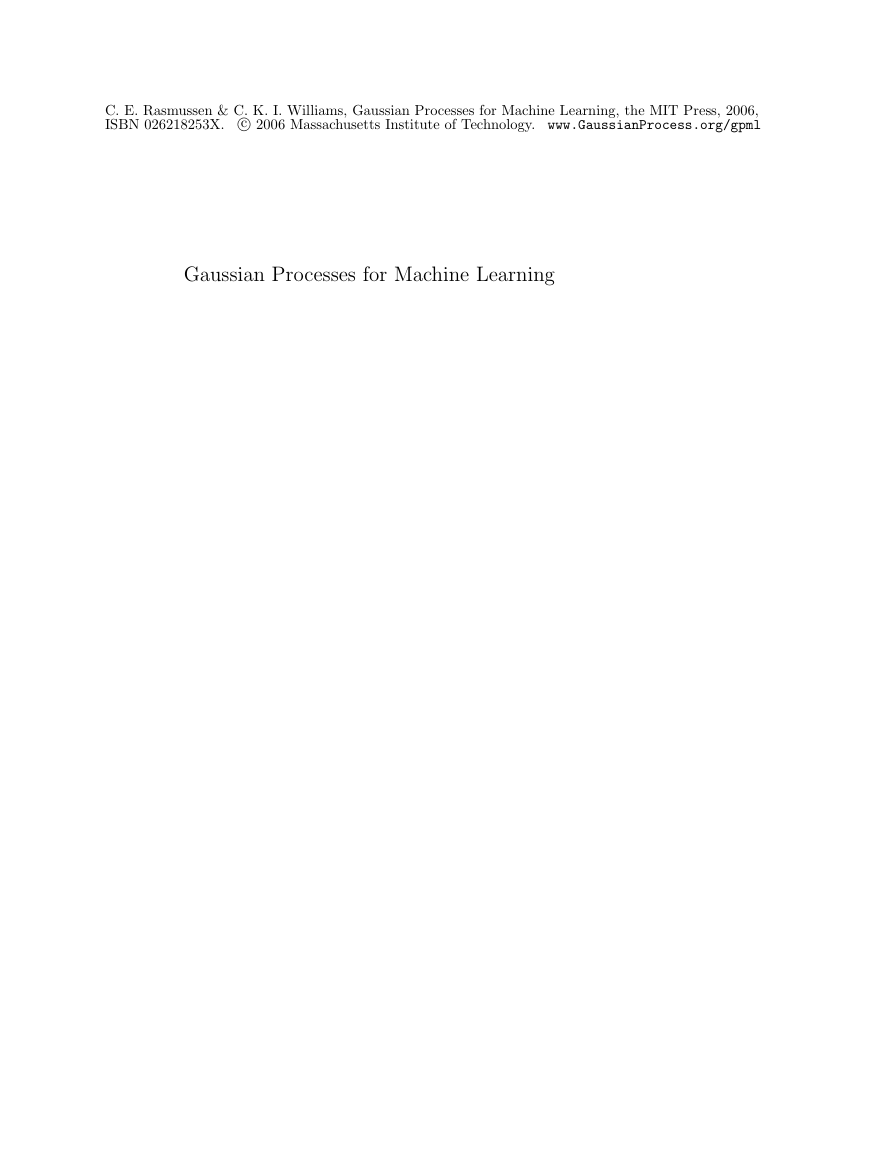
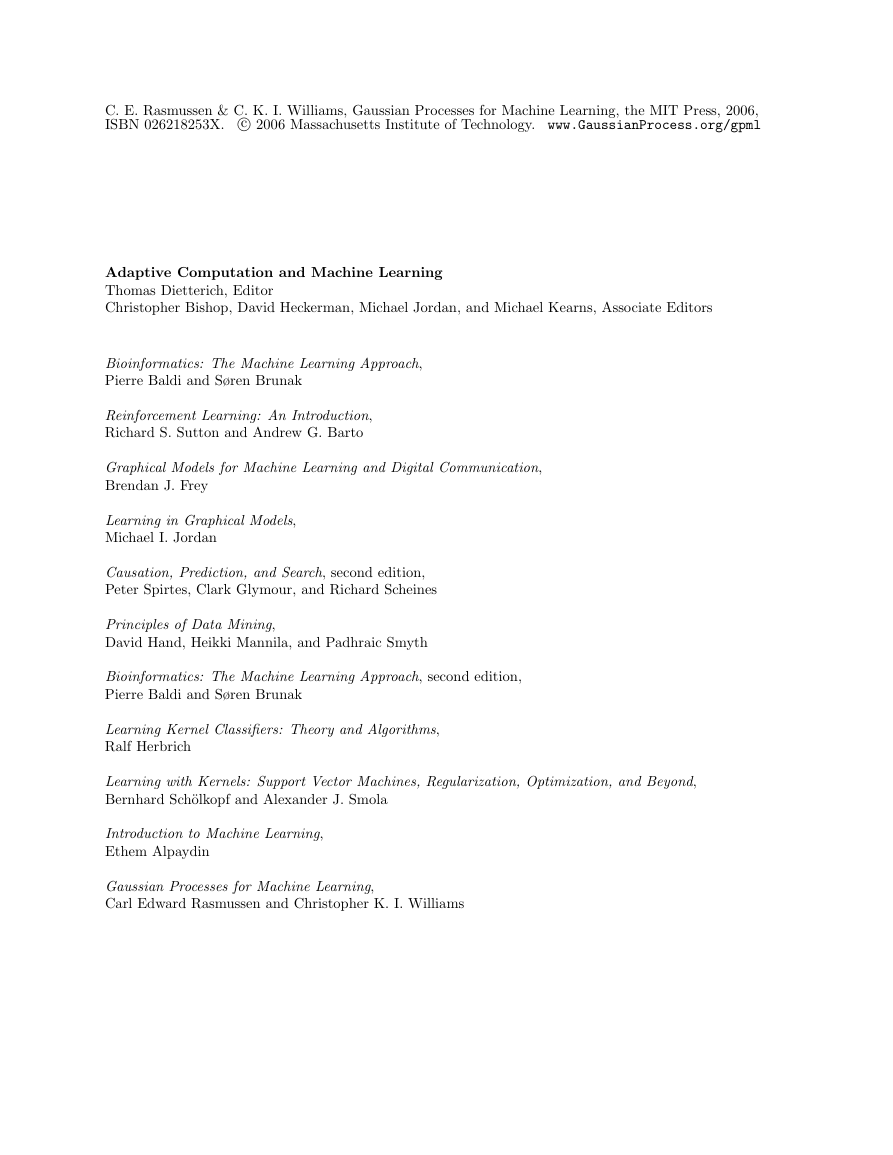

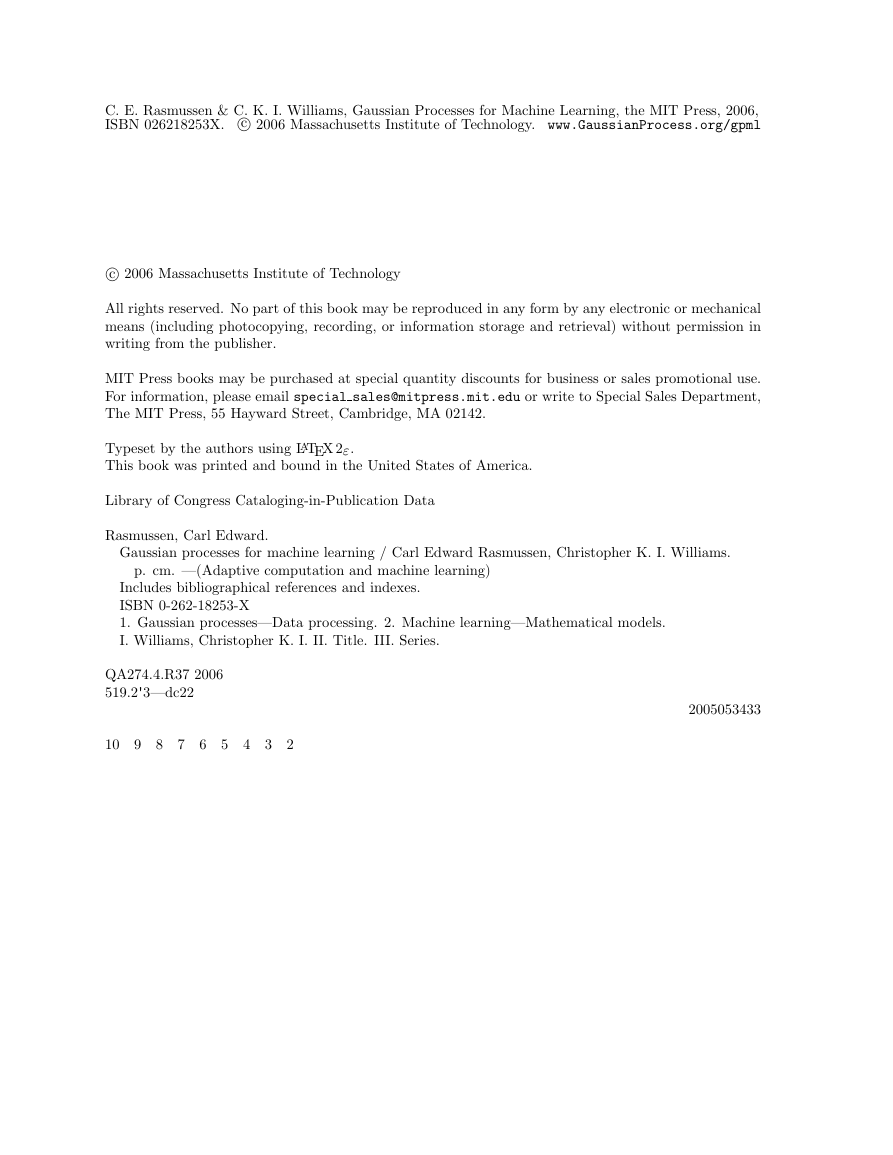
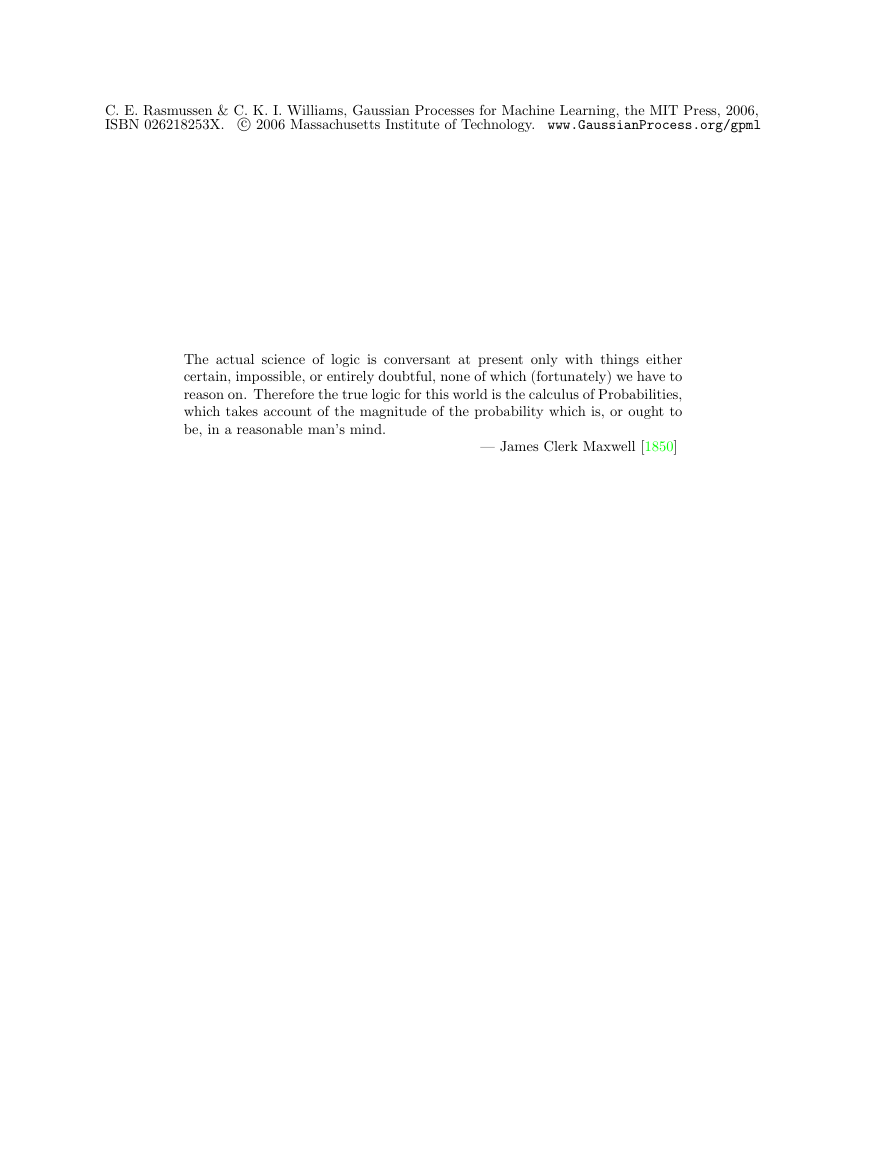


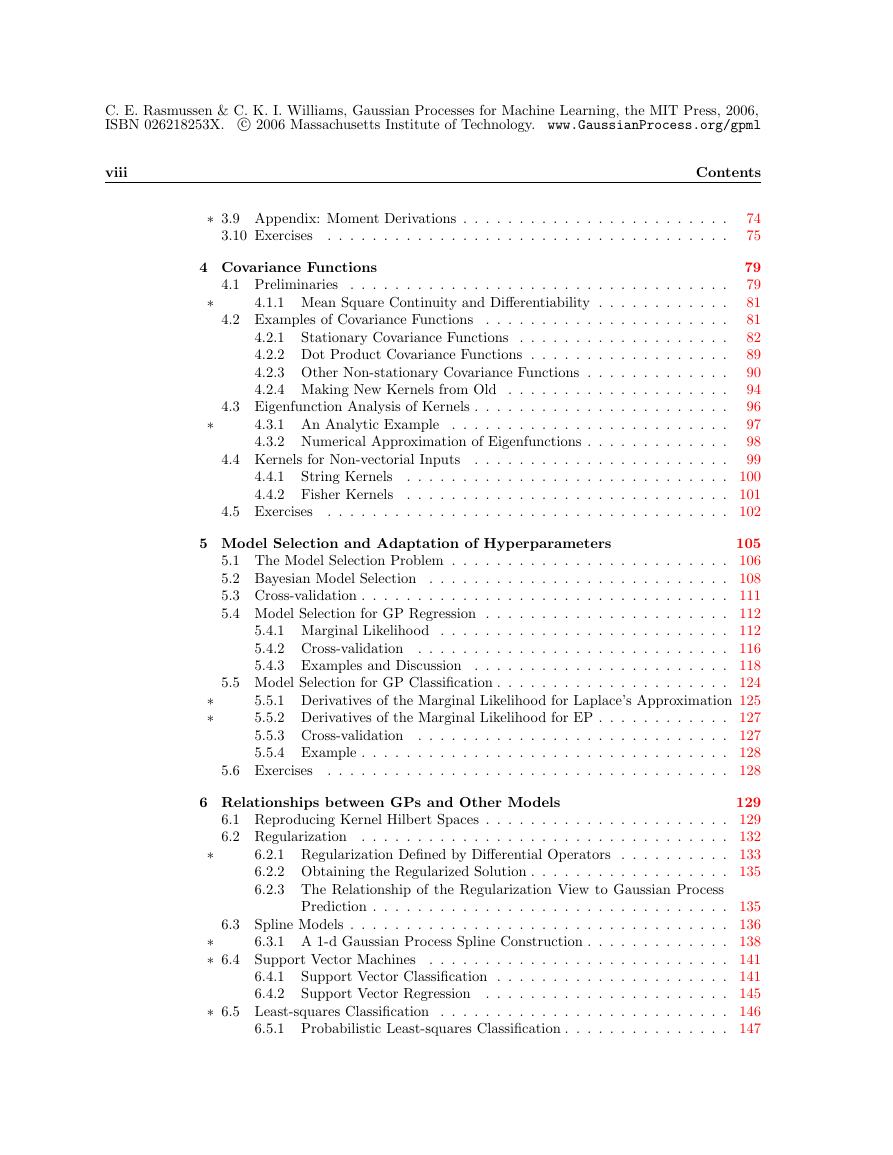








 2023年江西萍乡中考道德与法治真题及答案.doc
2023年江西萍乡中考道德与法治真题及答案.doc 2012年重庆南川中考生物真题及答案.doc
2012年重庆南川中考生物真题及答案.doc 2013年江西师范大学地理学综合及文艺理论基础考研真题.doc
2013年江西师范大学地理学综合及文艺理论基础考研真题.doc 2020年四川甘孜小升初语文真题及答案I卷.doc
2020年四川甘孜小升初语文真题及答案I卷.doc 2020年注册岩土工程师专业基础考试真题及答案.doc
2020年注册岩土工程师专业基础考试真题及答案.doc 2023-2024学年福建省厦门市九年级上学期数学月考试题及答案.doc
2023-2024学年福建省厦门市九年级上学期数学月考试题及答案.doc 2021-2022学年辽宁省沈阳市大东区九年级上学期语文期末试题及答案.doc
2021-2022学年辽宁省沈阳市大东区九年级上学期语文期末试题及答案.doc 2022-2023学年北京东城区初三第一学期物理期末试卷及答案.doc
2022-2023学年北京东城区初三第一学期物理期末试卷及答案.doc 2018上半年江西教师资格初中地理学科知识与教学能力真题及答案.doc
2018上半年江西教师资格初中地理学科知识与教学能力真题及答案.doc 2012年河北国家公务员申论考试真题及答案-省级.doc
2012年河北国家公务员申论考试真题及答案-省级.doc 2020-2021学年江苏省扬州市江都区邵樊片九年级上学期数学第一次质量检测试题及答案.doc
2020-2021学年江苏省扬州市江都区邵樊片九年级上学期数学第一次质量检测试题及答案.doc 2022下半年黑龙江教师资格证中学综合素质真题及答案.doc
2022下半年黑龙江教师资格证中学综合素质真题及答案.doc